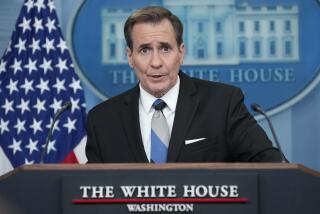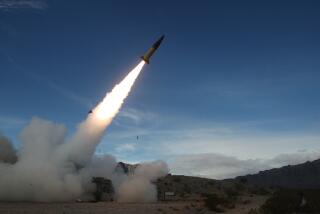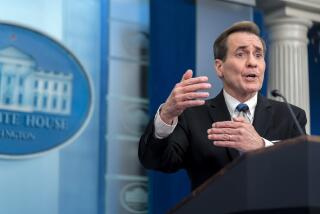U.S. Declassifies Details on Its Chemical Weapons, Challenges Soviets to Do Same
GENEVA â The United States made public Thursday previously classified details on its arsenal of chemical weapons and challenged Moscow to be equally âopen and candid.â Soviet negotiator Viktor L. Issraelyan promptly rejected the challenge.
Washington said that its aim in giving the information to a 40-nation disarmament conference in Geneva was to accelerate negotiation of a global treaty banning chemical arms.
U.S. delegate Thomas Barthelmey, releasing a 53-page Army document entitled âChemical Stockpile Disposal Program,â said the United States would rather have such a treaty than go ahead with its modernization program, which calls for the destruction of existing weapons and their replacement by a smaller stockpile of safer modern arms.
Speaking in Bonn soon afterward, Issraelyan, who is in charge of chemical arms talks for the Kremlin at Geneva, said Moscow would reveal details of its chemical arms stocks only when a convention is signed that prohibits the weapons.
The U.S. document described specific chemical agents and their storage sites, as well as how and where they will be destroyed.
Storage Sites
It said U.S. arms are stored at Aberdeen Proving Ground in Maryland, Anniston Army Depot in Alabama, Lexington-Blue Grass Army Depot in Kentucky, Newport Army Ammunition Plant in Indiana, Pine Bluff Arsenal in Arkansas, Pueblo Army Depot Activity in Colorado, Tooele Army Depot in Utah and Umatilla Army Depot Activity in Oregon.
The document described the stockpiled weapons as falling into three basic categories--nerve agent VX, nerve agent Sarin (GB), and mustard agents H, HD and HT.
The exact number of weapons was not disclosed. Facilities for their destruction, the document said, are being built at Johnston Atoll in the Pacific Ocean southwest of Hawaii and at the Pine Bluff Arsenal.
Western military analysts estimate that Moscow has 200,000 to 500,000 tons of modern chemical arms, including storage depots at 32 sites in the countries of its East Bloc allies.
âIt is the hope of my delegation that (the U.S.) disclosure will encourage others, who have thus far manifested reluctance to accept prompt disclosure of stockpile locations, to show flexibility on this issue,â Barthelmey said.
âAgreement on a chemical weapons ban would be facilitated by confidence that the parties will comply with its provisions, and it would help build that confidence if the nation with the worldâs largest stockpile of chemical weapons, the Soviet Union, would be open and candid about possessing chemical weapons stockpiles,â he said.
Unlike other countries, he said, the United States has not produced chemical arms for the past 17 years and must destroy its obsolete stockpiles and âmove to a smaller, safer CW (chemical weapons) deterrent.â
U.S. Preference
âWe would prefer, of course, to use this (disposal) plan as the basis for the complete elimination of all U.S. chemical weapons, in conformance with a comprehensive ban negotiated at this conference,â Barthelmey said.
A chemical weapons ban has been under discussion for eight years. Agreement on a treaty has been blocked by the problem of verifying the destruction of existing stockpiles and production facilities and preventing any future manufacture.
Moscow concedes it has chemical weapons but has never given specific details on type or location.
At the same time, it charges that a treaty would be almost impossible because the U.S. modernization plan involves so-called âbinaryâ weapons--two chemicals which are safe alone but lethal when combined.
More to Read
Sign up for Essential California
The most important California stories and recommendations in your inbox every morning.
You may occasionally receive promotional content from the Los Angeles Times.










